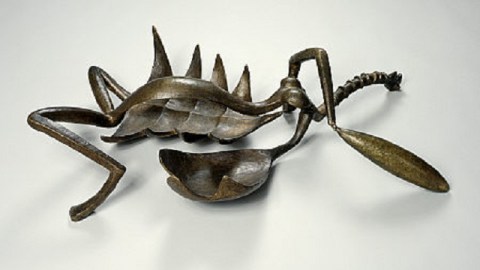Old Friends: The Surrealists at the National Galleries of Scotland

When Roland Penrose began buying artwork after returning to England in 1935, he focused on purchasing the works of the Parisian Surrealists—the circle of artists that had embraced him as one of their own. Old friends such as Dali, Magritte, Miro, Picasso, De Chirico, and others graced Penrose’s walls. Penrose left most of his collection to the National Galleries of Scotland, who bring the old gang together in Another World: Dali, Magritte, Miro and the Surrealists, an exhibition running through January 9, 2011. Scotland doesn’t seem like the obvious place for Surrealism, but isn’t that the point of Surrealism?
When Penrose first became interested in Surrealism in the 1920s, the word didn’t even exist in English—“super realism” or “sur-realism” were the common attempts. As the catalogue to the exhibition wonderfully explains, the story of British Surrealism centers on Penrose. “If the continental Surrealists had rallied to a common cause and consciously formed a group, in Britain it was a different story,” Patrick Elliott writes in the catalogue. “Instead, the artists selected for the [first London Surrealist] exhibition often discovered that they were Surrealists only when Penrose and [Herbert] Read came knocking at their doors, and informed them of the fact.” In many ways, this grand showing of the Scottish Surrealist treasure trove knocks on the door of the international art world and announces the strength in width and depth of their collection.
The National Galleries of Scotland began collecting Surrealist works in earnest in 1970, with the purchase of Alberto Giacometti’s controversially violent sculpture Woman With Her Throat Cut (shown above). Penrose’s collection exploded their holdings in the 1990s. The other major figure in the building of the Scottish Surrealist collection is Gabrielle Keiller, art collector and former woman golf champion. (It’s a Scottish story, so you knew there had to be some golf in there, didn’t you?) In 1960, Keiller met Peggy Guggenheim and quickly grew envious of Guggenheim’s collection. She soon began to buy Surrealists works, including some from Penrose. Years of working with the National Galleries of Scotland inspired Keiller to bequeath her collection to them, thus reuniting many of the works with Penrose’s collection.
The Scottish collection stretches from the proto-Surrealists such as Henri Rousseau all the way to the last surviving Surrealist, Desmond Morris, whose War-Woman captures the unreal existence of life for women during the Second World War in England. In between, all of the stars of Surrealism appear. Duchamp’s Fountain represents the early Dada roots of Surrealism. Important works from the 1920s by Joan Miro anchor the collection as a full tracing of the evolution of the movement. Figures such as George Grosz and Hannah Hoch appear to demonstrate that Surrealism spread across Europe beyond French borders. Keiller’s taste for Surrealist literature assured that the collection would have a full representation of the manifestos and periodicals that put Surrealism into words. The collage novels of Max Ernst, which influenced a whole generation of artists, appear in all their weird wonderfulness. Perhaps the most educational aspect of the collection is the inclusion of the overlooked British Surrealists, including Penrose himself. Seeing works by someone such as Cecil Collins, who “sympathies were more with William Blake than with Andre Breton,” you get a sense of how Surrealism slipped out of the hands of the Parisians and found a home in England through Penrose and through the local tradition itself of visionaries such as Blake the Romantic poet-painter.
Another World: Dali, Magritte, Miro and the Surrealists adds another chapter to the still-puzzling and still-intriguing story of the Surrealists, who allegedly “died” right after World War II but continue to live on in one shape or another. The National Galleries of Scotland collection gives them another life through Another World.
[Many thanks to the National Galleries of Scotland for providing me with a review copy of the catalogue to Another World: Dali, Magritte, Miro and the Surrealists, which runs through January 9, 2011.]





